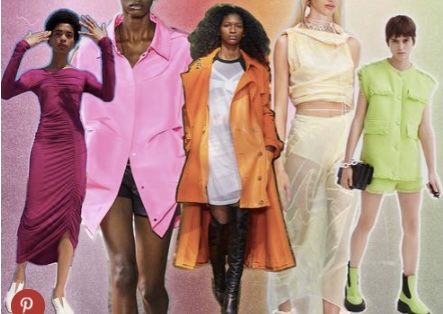You have no items in your cart. Want to get some nice things?
Go shopping
In these most dismal of the pandemic days, in the last, grey gasps of loneliness and anxiety, fashion explodes with neon-bright colours, clothes are layered, ruffled, indulgent, and designer logos are big, brassy and bold.
At a time when any sentient human could only feel restless despair, the new season’s trends declare us happier than ever. Fashion seems to operate in a parallel existence, ignorant of mounting death tolls and mutant variants, apparently unaware that most of us are still wearing blankets as clothing.
This bare-faced joy is unsettling. It is jolting, strange, to see Gucci selling accessories festooned with Disney characters for hundreds of dollars apiece, or to receive instructions from our loungewear to “spread positivity” when we are more concerned about spreading disease.
So what’s going on? Fashion is grinning manically through our collective breakdown, still dancing when the party is decidedly over (McKinsey estimates the industry’s profits declined by 93% in 2020). The elite spectacle of fashion week has moved online, robbing formerly invite-only events of their splashy cachet and leading some top designers to cancel events entirely, while High Street retailers haemorrhage money as stores remain shuttered through extended lockdowns.
Fashion faces a genuine existential crisis. The industry is inherently social – designers sell us transformation, promising social acceptance and personal betterment in every garment. Fashion knows who we are and who we want to be, from the free-living, bob-haired flappers of the 1920s to the sharp-shouldered, permed executives of the 1980s.
But the industry cannot sell us a vision of our future selves when our prospects remain shapeless, unpredictable and more than a little frightening. Instead, the adaptive beast of fashion now offers something intensely personal, and at this particular historical juncture, priceless. Hope.
Labels promise light-hearted redemption in luxury purchases, from Stella McCartney’s sold-out SMILE-stitched rainbow jumper to Christopher Kane’s celebration of “More Joy” across everything from scarves to socks, while budget online retailers urge buyers to join the “Good Vibes Club” (established in the annus horribilis that was 2020, no less) and promise that “everything will be OK”.
But can a simple slogan T-shirt shift a mood, or alleviate the emotional and financial pain of the past twelve months? The theory of enclothed cognition holds that the clothes we wear can impact the way we think and feel, and fashion psychologists like Dawnn Karen point to the “healing modality” of colour.
Wearing a yellow sweater or announcing contentment through a stitched quip won’t make COVID-19 disappear, but may help to shake us out of our pandemic funk. Adam Galinsky, whose research has demonstrated that wearing a white lab coat can improve people’s ability to pay attention to a task, thinks that staring at ourselves on video calls all day might mean our clothes have even more psychological impact than normal because their symbolic power is “even closer to our consciousness”.
But while seeing ourselves and those around us as at least surface-level happy could well lift our spirits, it is equally true is that we often choose clothes which reflect our existing state of mind – “mood illustration”, as Karen puts it.
And right now fashion’s “new optimism” feels too out of step with the prevailing gloom. Disco dresses and gelato pastels are tempting, but too sweet for the current palate. Of course retailers want us to feel better – feeling positive about the future encourages spending today.
I’ll get to the 2021 trends in time. But first, I might need a vaccine for a dose of scientifically-approved optimism.

About Clare Kane
Clare is a fashion writer and novelist based in London, and is particularly interested in the social, cultural and historical reasons behind why we wear what we wear. She is the author of Chinese historical fiction novels Dragons In Shallow Waters and Electric Shadows of Shanghai.




